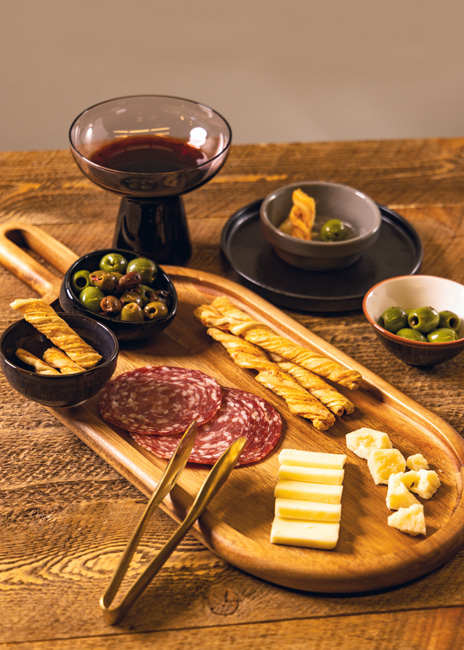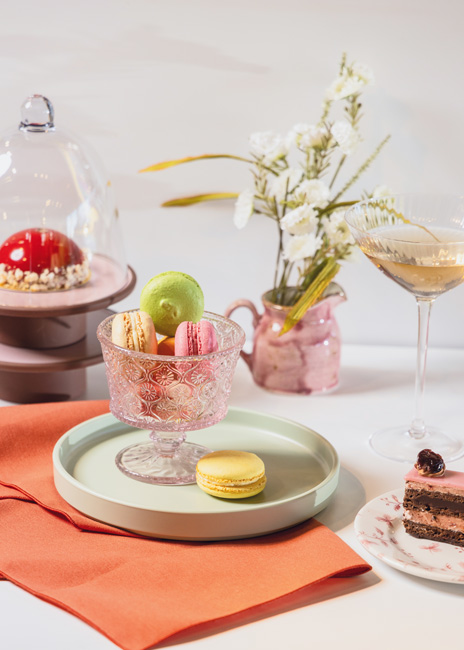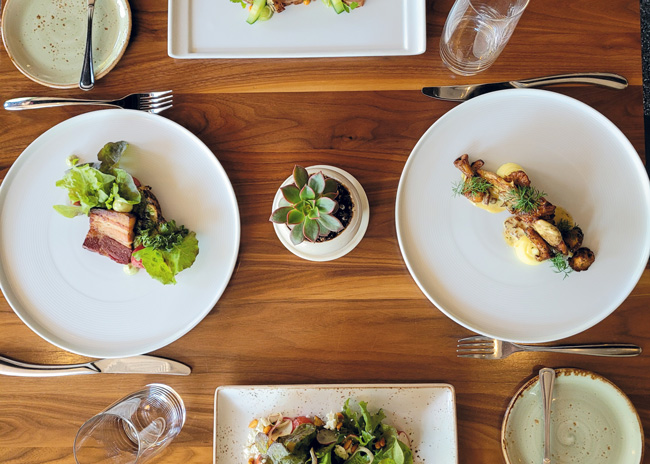No rules exist when it comes to creating impressive and memorable table settings.
Because foodservice operations will not get a second chance to make a first impression, banking on tabletop decor becomes an important investment. The goal remains simple: present the food in the best way possible.
“Restaurateurs typically lead the trends in tabletop design,” says Julie Pandl, business development manager, The Boelter Companies, a Wisconsin-based foodservice equipment and supplies dealer. “Other segments usually fall in as the styles evolve, unless it’s an exceptionally trendy hotel with a signature food program. Independent chef influencers also set the trends.”
What’s popular varies by brand as well as locale. “Especially after the pandemic, there are cities other than New York and Los Angeles that have people seeking an elevated fine-dining experience,” says Sarah Bulmer, lead tabletop specialist, Singer Equipment Companies, an Elverson, Pa.-based foodservice equipment and supplies dealer. “However, making dining experiences comfy and cozy isn’t going anywhere,” she adds.
With today’s tabletops, just about anything goes. “Prior to the pandemic, there were discernible trends whether in color, shapes or materials,” says Shannon Tallon, corporate category manager for front of house at Edward Don & Company, a Woodridge, Ill.-based foodservice equipment and supplies dealer. “In the current atmosphere, it feels like there are no specific trends.”
Trending Tabletops
Looking at new products in the marketplace, tabletop items exist to satisfy just about all tastes, visions and budgets.
 Photo courtesy of The Boelter Companies“When we look at the past 10 to 15 years, the market was dominated by porcelain and maybe melamine; now we have porcelain, stoneware, vitrified ceramic and other plastics that lead to more options for operators and better experiences for diners. If you are opening a restaurant, have a curated vision and want soft matte pastels, it exists. If you want bold jewel tones, these are available in new products,” says Tallon. “The reactive glaze trend was hot and heavy for so long and is now standard; operators have to have these in their portfolio.”
Photo courtesy of The Boelter Companies“When we look at the past 10 to 15 years, the market was dominated by porcelain and maybe melamine; now we have porcelain, stoneware, vitrified ceramic and other plastics that lead to more options for operators and better experiences for diners. If you are opening a restaurant, have a curated vision and want soft matte pastels, it exists. If you want bold jewel tones, these are available in new products,” says Tallon. “The reactive glaze trend was hot and heavy for so long and is now standard; operators have to have these in their portfolio.”
It’s not just about the availability of different designs but also new techniques and technology. For example, stoneware has been around for decades, but new versions upgrade the quality and appearance. “In some cases, you can’t even tell it’s stoneware, since the production process has improved,” Tallon says. “We’re also seeing porcelain made to look like stoneware.”
Melamine also has been upgraded, and its use has expanded. “While melamine has been around for decades, this was a category that was pigeonholed for poolside and outdoor dining,” Tallon says. “This is a narrow-minded perspective, as melamine has endless applications in all areas of foodservice.”
Operators can choose from different quality tiers, with a bevy of colors, styles and thicknesses. “The up-front investment may be more, but melamine will last longer than china, since it’s more durable,” Tallon says.
With the younger generation more keyed into dining experiences, operators must take an even more thoughtful approach to their tabletop designs. “That’s the No. 1 trend: a more thoughtful approach to how food is presented,” Bulmer says. “Also, we’re seeing a lot more tasting menu projects for 2024.”
Allison Krepop, key account manager at The Wasserstrom Company, a Columbus, Ohio-based foodservice equipment and supplies dealer, says mixing materials represents the biggest trend popping up in her work. “It’s not just all stainless or all gold, but mixing metals, being playful and having fun,” she says. “It’s really finding inspiration from the European market, which is two years ahead of us and pulls from fashion.”
Operators now choose tableware to support specific food items rather than trying to go with one style for the entire menu. “Workhorse dinnerware still exists, but operators are also purchasing plates or vessels that capture a dish’s unique qualities,” Bulmer explains. “Operators are taking color and design cues with bright bursts of colors, florals, Victorian elements, yet we’re seeing a more modern take on that.”
Looking at overall styles, the more things change, the more they seem to stay the same. “Organic and bold colors, such as browns, earth tones, blues and greens, are still very much a part of tabletops, as are organic and artisanal vessels,” Pandl says. “Deep vessels, coupe shapes and trays are definitely still trending.”
Rather than rimmed or rolled-edge plates, Pandl sees a move toward more subtle rim embossing. “Vintage items still seem to be trending, as well,” she adds. “This includes coupes, cut glass, faceted and etched glassware for spritzes and old-school cocktails.”
Twists on retro tableware and items with global influences are on trend, too. “Scalloped-edge bowls are not old school but include more unusual edges, with kind of a retro vibe,” Pandl notes. “Also, international bowl shapes, like noodle bowls used not just for noodles, but for of different presentations [are more common].”
Bulmer sees an influx of Japanese elements coming into play. “There also are more Scandinavian-inspired designs with clean lines. ‘New Nordic’ is what I’d call it,” she says. “Take Santa Fe and put it in Oslo, and that is something that has started popping off in Los Angeles and New York City.”
Some tabletops incorporate unique touches and pieces that stand out to differentiate brands. “Reactive glazes are still in, and there is some gold in metalware but as an accent piece,” Pandl says.
 Mixing materials is one element of tabletop that seems to be top of mind for 2024 noted Allison Krepop of The Wasserstrom Company. Photo courtesy of The Wasserstrom CompanyMixing sizes, shapes, textures and materials represents an ongoing trend. “This includes shorter water glasses and taller wine glasses, multiple textures across the tabletop with both embossed and satin-finished flatware,” Pandl says. “Different shapes are combined, such as round chef trays alongside rectangular appetizer plates.”
Mixing materials is one element of tabletop that seems to be top of mind for 2024 noted Allison Krepop of The Wasserstrom Company. Photo courtesy of The Wasserstrom CompanyMixing sizes, shapes, textures and materials represents an ongoing trend. “This includes shorter water glasses and taller wine glasses, multiple textures across the tabletop with both embossed and satin-finished flatware,” Pandl says. “Different shapes are combined, such as round chef trays alongside rectangular appetizer plates.”
Sustainability has been top of mind for foodservice operators, and that includes the tabletop. “We’ve seen people play around with recycled materials to help tell a sustainable story,” Bulmer says. “It may not always translate to diners, however.”
Taking tableware to the next level not only creates a memorable first impression but also can help justify necessary price increases. “It changes a $10 cocktail to a $20 cocktail, as the presentation allows for markups,” says Krepop.
Home decor also influences some of today’s tabletop designs. “When you look at fashion, metallics and fur are big. It’s the same thing with tabletops but in a different way,” says Lisa Hackworth, Wasserstrom’s product and marketing specialist. “That’s what generates more interest, taking stainless and black as basics and adding textures.”
Operators keep mixing various textures to create a different feel and signature presentation. “There are textures and colors with nature, like granite, terra cotta, carbons, even china comes out looking like iron,” Hackworth says. “Also, many accessories are being mixed, with melamine, metallic, stainless, brass, gold, gold with brushed stainless.”
Many seek an appearance of comfort, without being sterile. “We’re seeing wood as an element to warm up tabletops,” Hackworth notes. “This is not new, but walnuts and darker maples are replacing bamboo.”
Table lighting also has received a makeover, with LED lamps replacing fluorescent bulbs and candles, Krepop notes.
Social Media Influences
Social media has not only put food front and center but also the accompanying tabletop decor. “Instagram and other social sites are certainly a part of marketing these days,” Pandl says. “Many chef influencers post their creations in or on their preferred vessels, and they trend on social immediately.”
 Boelter Companies’ Julie Pandl points to retro vibes, global influences and a mixing of shapes and textures as on-trend for tabletops today. Photos courtesy of BoelterBoelter regularly receives Instagram screenshots from clients asking for specific tableware pieces. “Requests to look like influencers are not limited to chefs, either; beverage folks are also influenced by the latest cocktail creation — wine glass, coupe, tub, etc.,” Pandl notes. “From a purely showcasing-your-product standpoint, social media, and Instagram especially, is a great way for restaurateurs to get products out there.”
Boelter Companies’ Julie Pandl points to retro vibes, global influences and a mixing of shapes and textures as on-trend for tabletops today. Photos courtesy of BoelterBoelter regularly receives Instagram screenshots from clients asking for specific tableware pieces. “Requests to look like influencers are not limited to chefs, either; beverage folks are also influenced by the latest cocktail creation — wine glass, coupe, tub, etc.,” Pandl notes. “From a purely showcasing-your-product standpoint, social media, and Instagram especially, is a great way for restaurateurs to get products out there.”
Experiences have changed the game in the hospitality industry, and social media has become a word-of-mouth amplifier. “More than ever, restaurants and dining have become such an integral part of our pop culture,” Bulmer says. “Whether it’s due to social media or vice versa is up for debate, but Instagram is being adapted in restaurant spaces that are about food and dining but also about the experience; this has changed the game of hospitality, taking things beyond ‘What can I get you?’ to ‘How can I serve this to you in the most memorable and impactful way?’”
Social media has created a heightened awareness of dining experiences. “Decision-makers were always aware of customer experiences, but now they can’t escape it,” Tallon says. “Whether or not social media is or is not dictating trends remains to be seen, but it has changed the way operators curate their tabletops.”
It’s now about capturing people’s attention, and social media is the easiest, fastest and most affordable way to accomplish this. “Everyone is always chasing the perfect Instagram shot,” Krepop says. “We live in an age where everyone’s life is out on social media, and restaurants and hotels need to keep that in mind to be thoughtful of tabletop displays.”
Expert Advice
New tabletop designs and refreshes don’t have to break the bank. And it’s okay to mix and match colors, styles, textures and even themes.
“Obviously, if you’re updating banquet china, you need to make an investment, but you can refresh with two or three really unique pieces for specials,” Pandl says. “If you’re doing custom, I would choose one piece to customize rather than the whole pattern.”
For starters, the space needs to be cohesive with the tabletop. For example, melamine would not fit well in a fine-dining concept.
 The tabletop presentation at Vida in Indianapolis is as carefully curated as the restaurant’s four- and six-course tasting menus. Photo courtesy of Edward Don & Company“The light or lack thereof should be taken into consideration when choosing materials with relative qualities,” Pandl advises. “Look at the items in your space when customers will be dining — morning, noon, evening. Put food and drink items on the table with food and drink in them prior to making final decisions. Also, consider durability of product and handling and warewashing challenges.”
The tabletop presentation at Vida in Indianapolis is as carefully curated as the restaurant’s four- and six-course tasting menus. Photo courtesy of Edward Don & Company“The light or lack thereof should be taken into consideration when choosing materials with relative qualities,” Pandl advises. “Look at the items in your space when customers will be dining — morning, noon, evening. Put food and drink items on the table with food and drink in them prior to making final decisions. Also, consider durability of product and handling and warewashing challenges.”
Incorporating a focal piece can change the overall appearance of a tabletop. “Put something in the center of the table that works with the color palette and provides a focal point or an interesting height difference,” Pandl says. “Selecting a complete china range of matching products is not as interesting as coordinating or incorporating complementary products that are within the design scheme of the space. Be cognizant of color trends. Because so many are choosing color, it can be easy to get mired in the trends of past years as manufacturers tend to copy the products of style leaders.”
Pandl also encourages operators to be aware of flatware quality, as it’s a very intimate piece of the place setting that diners will pick up and put in their mouth. “Cohesion is important, but also don’t be afraid to go into a slightly different direction,” Pandl says.
It’s important to test a tabletop vision first before pulling the trigger. “I encourage operators to be flexible with their vision and take it for a test ride before committing to tableware,” Pandl says. “Work with vendors and distributor partners to have a couple options to make sure all elements of the dining experience come together.”
Just as eating out should be fun and entertaining, so should tabletops. “If you’re having fun with it, so will your guests,” Hackworth says.



